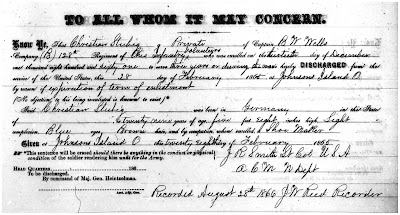Rush Richard Sloane was born in
Sandusky in 1828, the son of John Sloane and Cynthia Strong Sloane. (Cynthia’s father Abner Strong was said to be a leader in the Underground Railroad in
Ohio.) When he was only 16 years of age, Rush R. Sloane studied law under prominent Sandusky attorney
F. D. Parish. Sloane practiced law until 1857.
Below is a circular from 1853 which announces that Rush Sloane would practice law in Supreme, Federal, District, and Common Pleas Courts throughout Northern and Central Ohio. His list of references included Jay Cooke, as well as many leading men of Sandusky, Buffalo, and several other locations.
During the 1850’s Rush Sloane was a leading abolitionist in Ohio. In 1852, he defended seven men escaping slavery. The men were released, but one of the former slaveowners, Louis Weimer, sued Sloane in the U.S. District Court in Columbus. Sloane was fined $3000 ($104,000 in 2021 dollars) and court costs. In appreciation of his support, several African American residents of Sandusky presented Rush Sloane with a silver headed cane.
 |
| This cane is on display at The Follett House Museum in Sandusky. |
In 1856 he attended conventions held in
Pittsburgh and
Philadelphia that laid the foundation of the Republican Party. On June 2, 1900, he was invited to the 1900 Republican Convention on June 19, though by that time Sloane had become a member of the Democratic Party.
Rush Sloane served as city clerk of Sandusky from 1855 to 1857, and was elected Erie County Probate Judge in 1857. In the early 1860s, he briefly moved to Chicago to be a special agent of the Post Office Department. By 1867 he had become president of the Sandusky, Dayton and Cincinnati Railroad, successor to the Mad River and Lake Erie Railroad. Because of several financial disputes, a challenge to his leadership of the railroad, and a charge of embezzlement from the company, Sloane fled to Europe for three years. By 1876, he had returned to Sandusky, and eventually cleared of the charges (although there may have been a paid settlement).
After his return to Sandusky, Sloane ran for mayor of Sandusky on the Democratic ticket. He served as mayor of Sandusky in 1879 and 1880. He had the Sloane House hotel built in 1880, and later built the Sloane block (aka Sloane Annex) which housed several businesses.
Rush Sloane died on December 21, 1908. He was survived by his third wife, the former Helen F. Hall, two sons, and two daughters. From 1899 until the time of his death, Rush Sloane served as president of the Firelands Historical Society.
There is a wealth of historical information about Rush R. Sloane at the Sandusky Library and the Sandusky Library Archives Research Center. Charles E. Frohman, in his index to the Sandusky Register, features over 50 index cards with newspaper citations relating to Rush R. Sloane. A large portion of the biography of I.F. Mack, entitled Sandusky's Editor, by Charles E. Frohman, is devoted to Sloane. I.F. Mack was very vocal in his criticisms of Sloane, and as editor of the Sandusky Register he voiced his opinions often.
 |
| I.F. Mack (1837-1912) |
Residents of Sandusky may have had mixed feelings about attorney, businessman, former Mayor, and abolitionist Rush R. Sloane, but there is no doubt that Rush Sloane was an important figure in the history of Sandusky.

 this blog
this blog





























